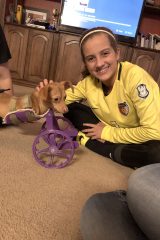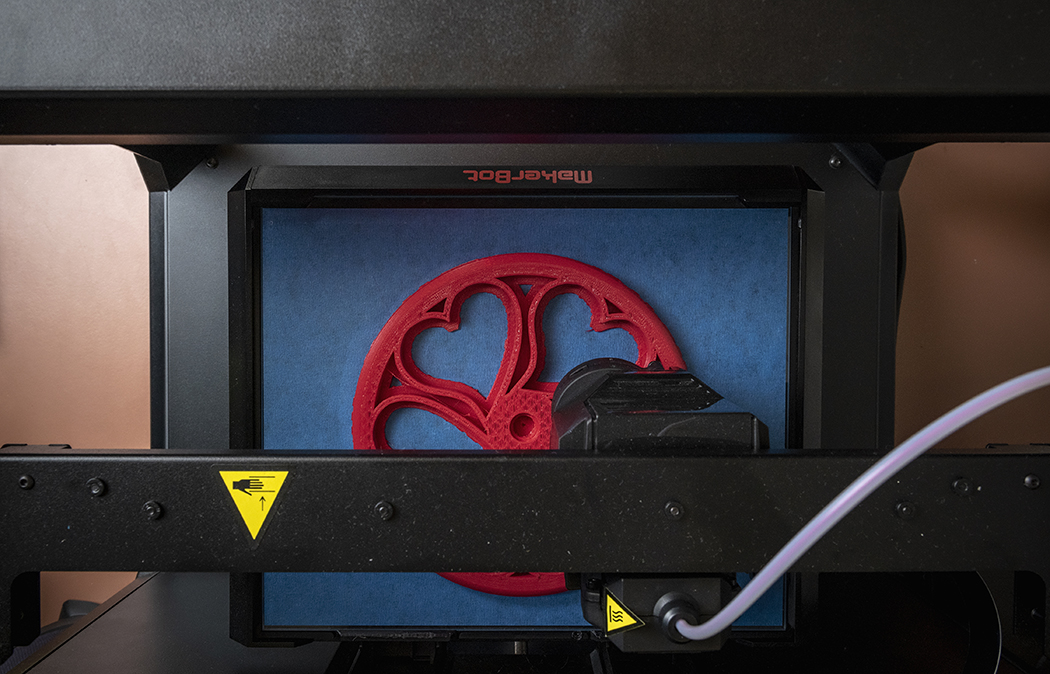
Photo by Danny Fulgencio.
Four legs good, two legs bad. Libby, an 8-month old Chihuahua, knows that truth more acutely than any of the critters in George Orwell’s “Animal Farm.”
With only two legs, Libby’s mobility was reduced to hopping and scooting until Lakehill Preparatory seventh-grader Lily Bracken came to her rescue with a 3D-printed wheelchair.
Bracken designed the wheelchair last fall while taking Evelyn Tan’s Maker Space class. In the class, students are asked to develop a product while working independently on a hobby or project. While most students chose to tackle painting, weaving or building a giant castle out of Legos, Bracken wanted to pursue a project that would help disabled dogs.
“Most projects are self-serving, and this was really the only project I had this semester that made something for someone else,” Tan says. “It shows what kind of person she is. I thought it was amazing.”
Bracken met Libby through contacts at White Rock Dog Rescue, where the 13-year-old had previously volunteered. As a puppy, Libby was attacked by other dogs. Both her front legs were broken and had to be amputated.
“I love dogs, and I started researching dogs who have disabilities online,” Bracken says. “I wanted to do something that helps.”
She began by building a prototype out of PVC pipe until finding a 3D template online. She drew the designs on digital software and then exported them to the printer. Each printer has a spool of plastic filament that is melted and then laid in layers to create multidimensional pieces.
 Trial and error was necessary to figure out how to design the chair’s six pieces so they could be easily assembled. The cost of error is low because the filament is cheap. The real cost is the time it takes to reprint a piece multiple times. Bracken’s largest piece, the wheel, took about six hours to print.
Trial and error was necessary to figure out how to design the chair’s six pieces so they could be easily assembled. The cost of error is low because the filament is cheap. The real cost is the time it takes to reprint a piece multiple times. Bracken’s largest piece, the wheel, took about six hours to print.
After three months, Bracken had created a lightweight, but sturdy, wheelchair in Libby’s favorite color, purple.
“She hated her wheelchair from the vet’s office,” says Elizabeth Rigor, Libby’s new owner. “She bit me a couple times because she was miserable. She didn’t want to get in it. I put her in the new wheelchair, and she had a big grin, and her tail was wagging. She gets around, and there’s no difficulties.”
Libby has since moved to Sherman with her owner and is training to become a therapy dog. “She’s a perfect advocate for bullying because she has two legs,” Rigor says. “You’d be surprised how many people make fun of her. Kids with disabilities don’t feel like they have disabilities when they see her because she gets around.”
As for Bracken, she is finishing two other wheelchairs and would like to experiment next with animal prosthetics. Someday she’d like to create a nonprofit to help disabled dogs and run her own animal shelter.
“I’ve learned to just go for it,” Bracken says. “If there’s something in the way to stop you, just keep going.”

Photo by Danny Fulgencio.





